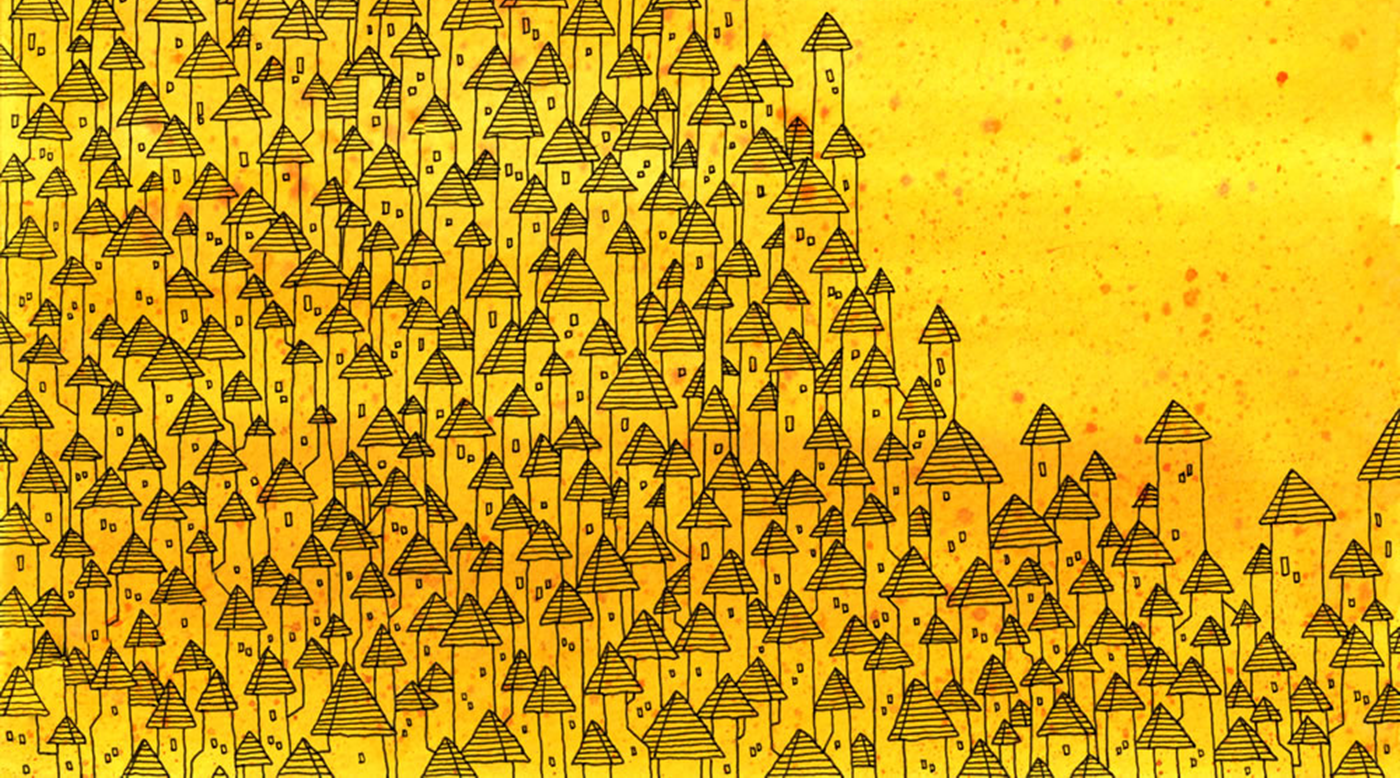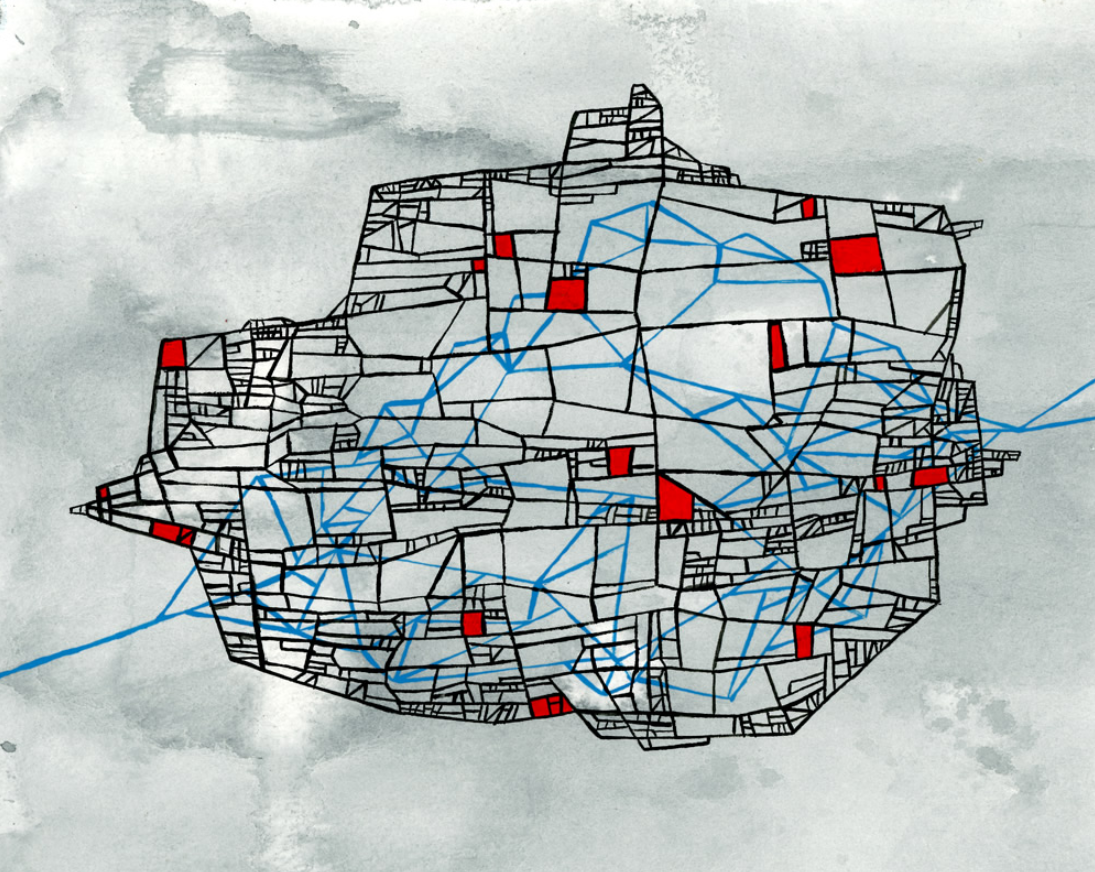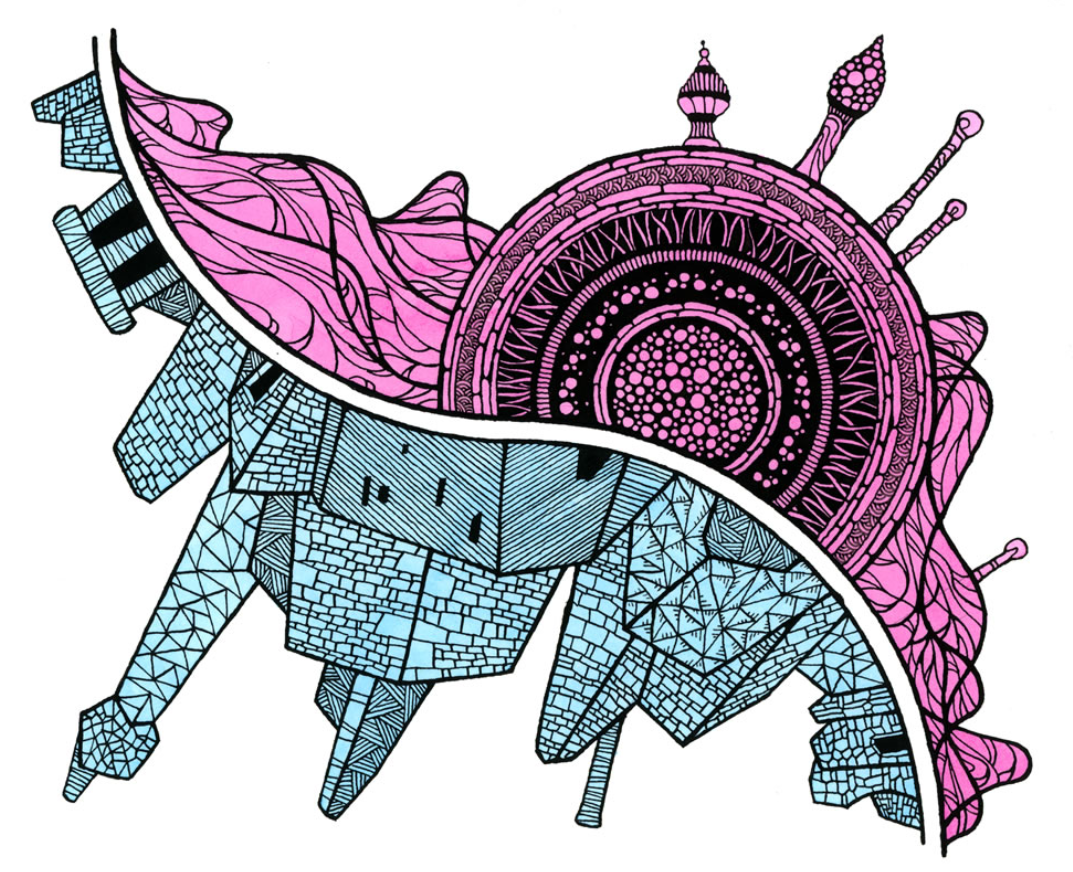This final post on the 2017 4CITIES September Salon spotlights the UNICA keynote speakers at the Salon – alumni Anja Petrovic and Predrag Milic – and presents the story of Polipnyx, a forgotten invisible city, written by Predrag and fellow alum Viktor Hildebrandt.

In addition to the Invisible Cities game we played on the street of Brussels, the 2017 4CITIES September Salon featured two talks, each by a pair of alumni. Anja Petrovic (Cohort 06) and Predrag Milic (Cohort 07) were brought in from Belgrade, thanks to the financial support of UNICA, as keynote speakers. Predrag, joined by Viktor Hildebrandt (Cohort 07), spoke first, as the two had previously collaborated on a joint thesis called Political Space Matters and have been working out ways of bringing its ideas into daily life and work since graduation. Anja then joined Predrag to talk about Škogled, the project the two of them have been developing in Ledine, a peripheral and somewhat deprived neighborhood of Belgrade that has been a site of transformation and experimentation for decades.
We invite you to read previous posts on Field Notes that provide an overview of Political Space Matters and Škogled. And then to dive into the story below, which Predrag and Viktor wrote in homage to Italo Calvino for the September Salon, where they read it aloud onstage, and which touches on one of the major challenges that both projects presented at the Salon are engaging in creative and productive ways: how to move from ideas to action and from dreams to waking life. The illustrations throughout are by artist Matt Kish.
Polipnyx: A Forgotten Invisible City
by Viktor Hildebrandt & Predrag Milic
Prologue
Last summer, after we had graduated from 4CITIES, Predrag and I, Viktor, visited a flea market. It was comparable in size and atmosphere to the wonderful Place du Jeu de Balle here in Brussels. We were hopping from one stand to the next, not looking for anything in particular. We found old jewelry and cutlery, rugs, furniture, kitchen equipment, toys and record collections. We also skimmed through large numbers of used books, hoping that perhaps we would stumble upon a hidden classic or a curious title. Unfortunately, most of the merchants did not seem to care much about their books. They just piled them up on shaky tables or stacked them in huge carton-boxes without any apparent order or system. We saw recipe books next to old software manuals next to cheap horror stories next to outdated travel guides next to worn out porn magazines. There was, in other words, nothing of interest.
Only towards the end of our walkabout, when we had already visited almost every single merchant on the market and began to feel the hunger rising in our bellies, we found a small book stand that looked pretty well-organised. What is more, we were intrigued by the grey old lady that was sitting behind the little table. She was completely immersed in an unusually thick book and held a huge, very unhealthy-looking cigarette in the corner of her mouth. Coming closer, we noticed that the lady only sold fairy tales. Her collection was vast, ranging from classics such as Grimm’s Fairytales or One Thousand and One Nights to tales from Africa, Asia and even Alaska which, obviously, we had never heard of before. Skimming through her inventar, we stumbled upon what we had least expected: Jammed between a series of popular tales from Ethiopia and an assortment of Russian witch-stories, we found Italo Calvino’s Invisible Cities.
“Ha, funny!”, we mumbled. “Calvino! Who would have thought?” The grey lady was still chewing on her supersized cigarette and reading her book. We were wondering if she had actually noticed us at all when suddenly and without any introduction she said: “If I were you I would take a closer look at the final chapter…” Startled and perplexed we opened the last pages of the book. “Do you notice anything curious?”, she asked with a dim smile (the cigarette was about to fall out of her mouth). “Ummm … not really. What is there to notice?” We looked at her, then at each other, and back at her. (There must have been big question-marks above our heads.) “Hehehe”, the grey lady just giggled. “Well, are you going to tell us or not?”, we asked slightly annoyed.
“Have a little patience with an old lady, my youthful friends”, said the grey lady with a calm voice. Then she skillfully lit her cigarette and took a few puffs before continuing. Almost unwillingly, we got excited. “What you hold in your hands is a very, very, very rare copy of the – almost forgotten – second and a half edition of Invisible Cities. It contains one additional chapter that is not included neither in the two previous nor in any of the later editions; a chapter about a city outside of Kublai Khan’s empire. Please don’t ask me why it was included and then taken out again – I really have no idea…” Intrigued by this mystery, we started reading the last chapter – which was titled Cities and Politics I – immediately.

Cities and Politics I
Marco Polo addresses Kublai Khan one more time with carefully chosen words: “Greatest Emperor, by now I have given you my accounts of all of the cities that lie within the borders of your empire. As different as they all are from one another; they do have one thing in common: You hold them together. Your word is the law in all of them. What you command, it will be done. Finally, with your permission, I would like to tell you the story of only one more city. A city that is neither big nor small, neither rich nor poor, neither old nor new; but which is very special nonetheless. ‘Special?!’, you will ask, ‘Why?’
The city of Polipnyx is special because it lies outside of the borders of your vast empire and is thus not under your control. In case this offends you, my Emperor, I may be able to calm your nerves by highlighting that Polipnyx is, in fact, not ruled by any other ruler either. Polipnyx is part of no Empire. Instead, it is an independent, a free city-state which – and this is what makes it truly unique! – is governed by all of its inhabitants together. More precisely, perhaps, it is governed by all those who want to participate in the affairs of government.
This, you will assume, must result in chaos! How could thousands of people possibly take decisions together? … Take decisions, moreover, that actually work to promote the common good? You are of course right in assuming that this way of government is infinitely more complicated and often times less clear-sighted than the rule of one single and wise emperor such as you yourself are. And yet, the simple fact that Polipnyx remained free and independent for so many years indicates that the government by the many can work. At least it seems to work in this particular case.
‘So how do they do it then?’, I hear you asking already. There are many facets to this miraculous form of government. The one that I found to be the most ingenuous is architectural in nature: Many generations of inhabitants have built a large number of so called political spaces all over the city. These spaces are built for the sole purpose of discussing public affairs, just as a library is built for storing and enjoying books. This, to be sure, must seem strange at first glance. You may even argue that it is a completely unnecessary endeavour since, as everybody knows, it is possible to discuss public affairs anywhere and at any time. After all, the only thing people really do is talk. Believe me, my Emperor, I too have argued that way when I came to Polipnyx for the first time. But the residents just smiled at me understandingly. They assured me that I was right – the only thing they do in their political spaces is talk. And this, no doubt, can be done anywhere. But nonetheless, they continued to explain to me, some spaces would be much more suitable for discussing public affairs than others. To prove their point, they invited me to visit some of their most distinct buildings and I was happy to accept their invitation.

First they showed me a huge building with several dozens of entrance doors, each distinct in its own way. I was told that people from all walks of life would approach the building from different directions and that everybody would enter it through the door that seems to be the most fitting for them personally. Corridors lead from the entrances into the building. As you walk along ‘your’ corridor, you could talk to and understand everybody else in the entire building – except of the people that entered through the same door as you yourself did. The building is designed so that the more you disagree with the people in other corridors, the further these corridors lead away from each other. The more you agree, the closer they come. If you agree, they merge and become one. Only when all people have agreed, namely, in the very moment when the last corridors merge into one, does an exit come into sight. My guides emphasized that this building structure is incredibly helpful for taking tough decisions. (To avoid misunderstandings: There are emergency exits all along – but if you use them, you are no longer part of the decision making process.)
Later, we visited a veritable forest of towers which all were so high that they spiked the clouds. These towers were shaped like spirals and, curiously, they each got bigger and smaller on different levels. In some cases, the spiral of one tower was so big, that it almost seemed to swallow all the others. I couldn’t see them myself but I was told that there were construction workers on the tops of all of the towers constantly. Why? Because the towers serve to represent the history of Polipnyx. All important events, citizens and decisions are being carved into their stones in the form of words and images. One tower wasn’t enough, they told me, because reality can be viewed from many different angles. When I protested and claimed that facts are facts and that facts can only be true or false, my guides calmed me down: ‘Don’t worry’, they said. ‘The towers represent only our interpretations of reality. But they all share one and the same fundament which is made up of unambiguous and extremely stable facts and figures. It is only because we trust in the absolute certainty and inviolability of matters of fact that we can built our towers into the clouds.’

Then, on the way to the next stop of our tour I almost couldn’t believe my own eyes when I saw how a semi-transparent, semi-permeable space suddenly popped up out of nowhere. It was shaped like a bell, it also rang like a bell and the strokes of the gong filled the air with mild vibes. The space appeared right in the middle of a square where, just in that very moment, a small group of people had been arguing and lamenting fiercely. When the space took shape around them, the brawlers did not stop arguing – quite to the contrary – but their choice of words became more dignified and clear at once. Only in the comfort, safety and moderation of the political space could they really listen to and understand each other. Also the gongs of the bell attracted more and more spectators to the square. In just a few moments a knot of people gathered around the debaters as if they were boxers in a ring. We too stopped to watch. After half an hour or so there was nothing left to say – at least for the moment. The debaters did not agree in the end – far from it – and they did not arrive at any final conclusion. Yet they parted with firm handshakes and smiles on their faces. They all seemed satisfied as they had debated, at least primarily, for the purpose of debating. As soon as all claims were made and all arguments were presented, the space disappeared again and the crowd diffused. My guides and I continued our tour and along the way I came to realise that I had never before seen a city that was so full of statues and ornaments. Among the countless motives that my eyes saw, principles such as freedom or justice and virtues such as courage, respect or modesty were by far the most common ones.
Afterwards we reached one of the public discussion halls which, as I was told, exist in every single neighbourhood of Polipnyx. Each discussion hall is designed differently, depending on the structure and history of the surrounding area. The one that we entered was shaped like a supersized spinning top. (You know … like the ones that the children play with.) We entered the building through an ornamental wooden door which despite its beauty was very modest; and then walked through an entrance hall filled with references to local history and to the numerous weird distinctions of the families of that particular neighbourhood. To be honest, I did not understand any of it. Stairs lead upwards from the all sides of the hall into the tiers of spectators. The number of seats, my hosts informed me, adjusts magically to the number of people that enter the building so that the discussion hall will fit any occasion. In the centre of the building, between the tiers of spectators and right above the entrance hall, there was a stage for the protagonists. Numerous spot lights pointed towards the stage which is empty, except for a small pedestal and a high circular table (apparently there was no need for chairs as the citizens of Polipnyx are used to standing debates). Between the ranks and the stage there was a gap. This gap, I was told, is small enough so that everybody can jump across it and onto the stage; but wide enough so that even the tallest man will have to gather up quite some courage to jump. Everybody who is brave enough to jump is allowed to participate in the debate. The jump transforms him or her from an onlooker into an actor. The participants can enter only one at a time and each has to give a short opening statement on the pedestal before joining the debate.
There were many more buildings that we visited and each of them deserves to be described in detail. But, great Emperor, as your time is only too precious, I hope you will allow me to end my report here, before I begin to bore you.

Epilogue
After finishing the last few lines of the mysterious additional chapter on Cities and Politics, Predrag and I took a deep breath. “It makes sense”, Predrag said after a long moment of silence. “I mean”, he added, “the space where we engage with politics really matters. It affects what we do, how good we are at what we do, and – most importantly – if we act at all.”
“Sure”, Viktor reaffirmed. “But, unfortunately, in reality we cannot build sky-spiking spiral towers that grow infinitely as history is being written. We cannot create buildings that adjust to the number of visitors, corridors that merge magically or semi-transparent pop-up spaces that just appear out of nowhere.”
“Of course not!”, the grey lady suddenly interrupted our conversation. Enthusiasm, disappointment, anger and hope blended together in her voice: “This is why it is an invisible city, an impossible city, an illusionary city! And yet – as is the case with all of these cities – you will be able to find their traces in the real world, if only you look for them. And more than that: You can realise them, you can build them – if only you allow yourself to be guided by their invisibility, by their impossibility, by the illusions they produce.”
The lady lit her cigarette once again and then she disappeared.


